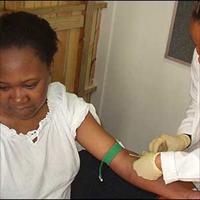SOUTH AFRICA: Poor tracking means patients lose out

Inadequate patient tracking at one of South Africa's largest antiretroviral (ARV) distribution sites, has led to many patients disappearing from the clinic before treatment starts, a new report has found.
The report by the Reproductive Health & HIV Research Unit (RHRU) of the University of the Witwatersrand, based on a 2006 review of patient files at the Tshepong Wellness Clinic, about 120km southwest of Johannesburg, shows that a standard percentage - about 14 percent - stop taking treatment, but more than 20 percent of patients never get to the treatment stage.
An initial CD4 count (measuring the strength of the immune system) for each patient - those who began treatment as well as those who did not - was an average of 95. This led researchers to question why patients with a CD4 count of below 200, who clearly qualified for free treatment, did not start receiving it.
Patients making a late start in taking ARVs probably contributed to the clinic's high mortality rate during the first months of treatment: about 80 percent of patients succumbed to tuberculosis, said Dr Francois Venter, head of the RHRU.
"It seems like if patients initial CD4 counts are so low, by the time drugs start to kick in ... they're so vulnerable," said Ambereen Jaffer, the RHRU's technical advisor for monitoring and evaluation. "They're so sick to begin with even when they start on treatment they are at risk of dying on treatment and that risk isn't reduced until after a couple of months."
The RHRU's staff could not determine where in the pre-treatment process patients at Tshepong clinic had disappeared from the system, but Jaffer said subsequent information gathered at inner-city clinics in Johannesburg indicated that almost 50 percent of pre-treatment patients were lost at the point where blood was drawn to determine CD4 counts.
Researchers have been unable to determine why this should be so, but Jaffer suggested it could be due to long delays in receiving laboratory results, or patients not understanding the importance of knowing their results.
The RHRU has developed a do-it-yourself guide for clinics wishing to conduct similar audits on their own files, an exercise Jaffer said might strengthen weak monitoring and evaluation (M&E) systems.
"If monitoring systems are strong, people will be able to pick up these trends," she said. "Based on what we've seen, and just talking to people, M&E skills are very weak,' Jaffer said.
"There's a fear and reluctance to pass the numbers on to external agencies or even their own supervisors. People are very cautious - they think if you are asking for numbers it's because you want to expose something, which is not always the case, she said. "Some people don't have a proper understanding of why we collect data. They think of it as extra work beyond their normal capacity."
According to health department spokesperson Charity Bhengu, 408,218 patients were receiving ARVs from 366 health facilities nationwide as of November 2007. The department could not be reached for further comment on whether the RHRU's findings were indicative of a national trend.
 Back and Next - Back and Next
Back and Next - Back and Next See Also - See Also
See Also - See Also